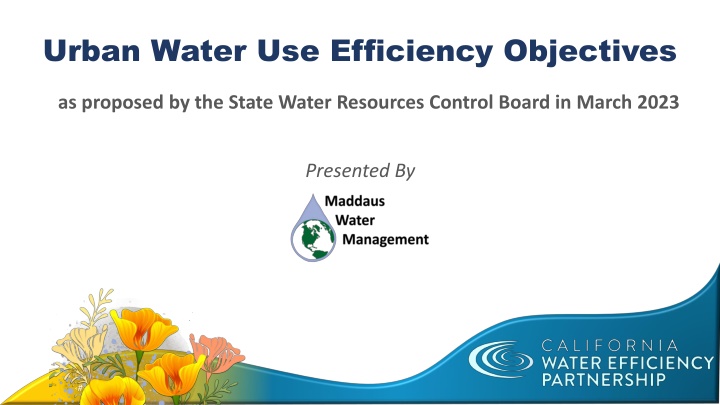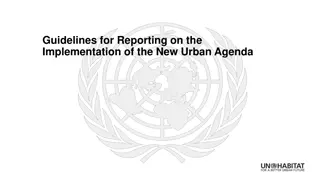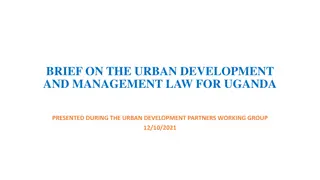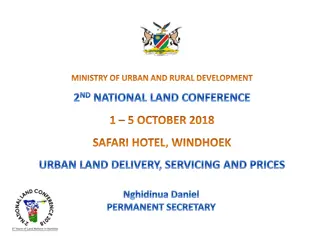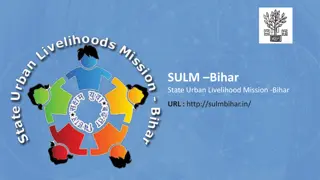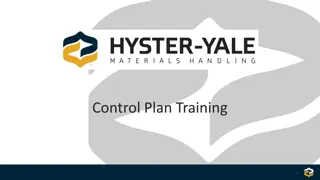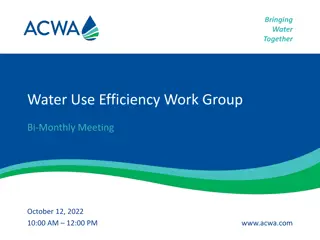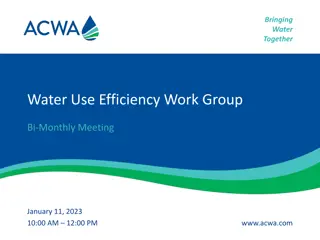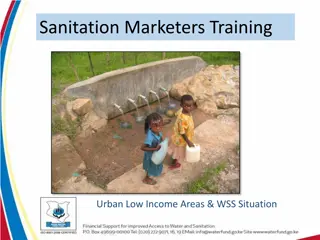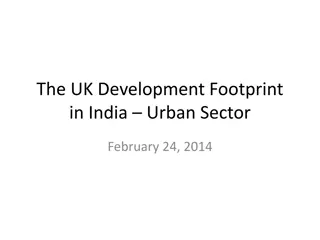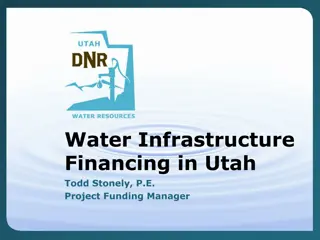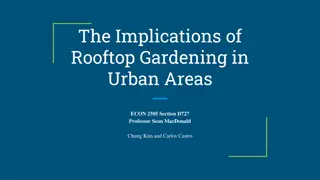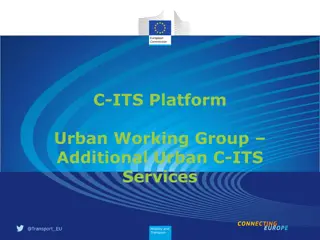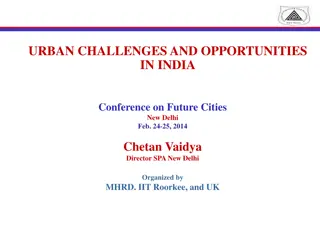State Water Resources Control Board's Urban Water Use Efficiency Objectives
The State Water Resources Control Board proposed Urban Water Use Efficiency Objectives in March 2023 to address the challenges of a hotter, drier future. The objectives include creating storage space for up to 4 million acre-feet of water, recycling and reusing at least 800,000 acre-feet of water per year by 2030, and supporting stormwater capture projects. The goal is to reduce annual urban water demand and promote water-saving practices. The regulation making process is ongoing to establish standards and components for efficient urban water use.
Download Presentation

Please find below an Image/Link to download the presentation.
The content on the website is provided AS IS for your information and personal use only. It may not be sold, licensed, or shared on other websites without obtaining consent from the author.If you encounter any issues during the download, it is possible that the publisher has removed the file from their server.
You are allowed to download the files provided on this website for personal or commercial use, subject to the condition that they are used lawfully. All files are the property of their respective owners.
The content on the website is provided AS IS for your information and personal use only. It may not be sold, licensed, or shared on other websites without obtaining consent from the author.
E N D
Presentation Transcript
Urban Water Use Efficiency Objectives as proposed by the State Water Resources Control Board in March 2023 Presented By #
Adapting to a Hotter Drier Future Create storage space for up to 4 million acre feet of water Recycle and reuse at least 800,000 acre feet of water per year by 2030 Support local stormwater capture projects in cities and towns with the goal to increase annual supply capacity by at least 250,000 acre feet by 2030 and 500,000 acre feet by 2040. Reduce annual urban water demand by at least half a million acre feet by 2030. #
Water Saving Associated with SWRCB Proposal As Estimated by SWRCB Staff #
Urban Water Uses in the New Framework What s In and What s Out? #
Calculating Urban Water Use Objectives Potable Reuse Water Bonus If applicable Standard Water Use Objective Variance If applicable Water Provider s Unique Water Objective Residential Indoor Outdoor Real Water Loss Residential Landscape CII Dedicated Irrigation Meter Providers will need to meet the SUM of the standards. #
Regulation Making - Where Are We? Standards, status of each component Draft Available (Most Recent) Components Final Approved Indoor Residential WUE Standard Yes 11/30/21 Yes 9/28/22 Water Loss Standard Yes 9/2/22 Yes 10/19/22 Outdoor Residential WUE Standard Yes 3/15/23 WUE Standards for CII Outdoor Irrigation of Landscape Area with Dedicated Irrigation meters Yes 3/15/23 Variances for Unique Uses of Water Yes 3/15/23 CII Water Use Performance Measures Yes 3/15/23 Guidelines and Methodologies for Calculating Urban Water Use Objectives Yes 9/29/22 #
Terminology BMP = Best Management Practice CII= Commercial, Industrial, Institutional DIM= Dedicated Irrigation Meter EP = Effective Precipitation ETAF= Evapotranspiration Adjustment Factor ET0 = Reference Evapotranspiration GPCD= Gallons Per Capita (Persons) Per Day LEF= Landscape Efficiency Factor MWELO= Model Water Efficiency Ordinance SLA = Special Landscape Areas UWUO= Urban Water Use Objective #
Residential Indoor Budget Defined in Water Code Section 10609.4 Residential Indoor Things to Think About: How will this impact your recycled water programs, wastewater systems? What do studies need to address? 1157 Standards - DWR/SWRCB Recommendation (GPCD) Year 2020-2024 55 X X = 2025-2029 47 365 Population Residential Indoor Budget 2030 + 42 No proposed changes since SB 1157 in 2022 #
Calculating Residential Outdoor Budget Residential Landscape Net Eto Reference Eto- Effective annual precipitation 0.62 Residential Outdoor Budget Residential Outdoor Standard Landscape Efficiency Factor Landscape Area Sq. Ft. of Irrigable + Irrigated Area Conversion Factor No proposed changes since SB 1157 in 2022 #
Residential Outdoor Budget Existing Landscapes Outdoor Year Standard INI Buffer 2020 0.80 Up to 20% Water suppliers would need to demonstrate need for INI Buffer 2030 0.63 Up to 20% 2035 Special Landscape Areas 0.55 1.00 Up to 20% NA Residential SLAs include areas irrigated with recycled water. Landscapes associated with new construction Year Standard INI Buffer Any 0.55 NA #
Defining Residential Special Landscape Areas Special Outdoor Landscape Areas #
Landscape Factors SWRCB Assumptions Outdoor #
CII Performance Measures Classification Best Practices Mixed Use Meters Conversion # #
CII - Classification SWRCB Proposal EnergyStar Portfolio Manager (ESPM) 18 Categories DWR Recommendation- 19 Categories # #
CII Best Practices Disclosable Buildings Defined by the CEC regulation Follow ENERGY STAR s Portfolio Manager Tool Multiple steps needed: Identify building owners Collect 12 months water use Provide building owners with water use data in an ESPM format # #
CII Best Practices, cont. Top 20% threshold per classification category (excluding process water) 1 BMP per five BMP categories Top 2.5% threshold 2 BMPs per five BMP categories Types of BMPS pr DWR Recommendations Planning and assessment BMPs Water Assessments/Water Audits Water Management Plans Water use specific actions and equipment BMPs Landscapes Incentives Operational Practices Educational and cultural BMPs Outreach Technical Assistance Collaboration and Coordination # #
CII Performance Measures Mixed Use Meters CII Dedicated Irrigation Meter Threshold to determine which CII landscapes qualify for conversion to DIM 500,000 gallons annually Properties impacted 72,033 DWR Recommendation was 1 acre Properties impacted 85,571 Defining "in-lieu" technologies Hardware, software, actions # #
CII with DIMs CII Dedicated Irrigation Meter Year Standard Through Sept. 30, 2030 0.80 Oct. 1, 2030 Sept. 30, 2035 0.63 Oct. 1, 2035 onward 0.45 All CII-DIM landscapes must be measured by 2028. DWR currently working on CII-LAM-LUCD Starting in 2028, suppliers will calculate their CII outdoor water budgets for those accounts with DIMs CII SLAs exclude areas planted with non-functional turf. # #
Defining CII DIM Special Landscape Areas CII Dedicated Irrigation Meter SLAs for CII landscapes with DIMs would be the same as defined under MWELO, with the following additional landscape types Bioengineered slopes; Ponds for recreation or for sustaining wildlife; Public swimming pools; Existing plant collections, botanical gardens, and arboretums; and Cemeteries built before 2015. #
CII Timeline # #
Other: Water Loss Variances Potable Reuse #
Water Loss Four Components to the Regulation Real Water Loss Individual volumetric real loss standard Questionnaires are due in 2023 Questionnaires on data quality, pressure management, asset management Apparent loss data submission Annual reports of breaks, repairs, and estimated water losses #
Variances Variances Added in SWRCB Staff Proposal Variance If applicable #
Bonus Incentive for Potable Reuse Potable Reuse Water Bonus If applicable #
Questions to consider How will this impact your agency? What data is needed? CII measurements DIM and MUM identified and located Special landscape areas? Variances? Water Loss Questionnaires How will you comply with CII requirements? Classifications BMPs Identifying top users (excluding process water) Reporting water use Other things? #
Resource Cheat Sheet SWRCB Rulemaking SWRCB Presentation Slides https://www.waterboards.ca.gov/water_issues/programs/conservation_ portal/regs/docs/2023/conservation_March_22_2023.pdf Recording https://www.youtube.com/watch?v=B-JTAUtg778 SWRCB Legislative Summary and Timeline https://www.waterboards.ca.gov/water_issues/programs/conservation_ portal/california_statutes.html CalWEP CII Water Use Classification and MUM Conversion System Resources https://calwep.org/commercial-industrial-institutional/ CalWEP Blog: What the Framework? https://calwep.org/the-state-board-releases-a-draft-framework-the- making-conservation-a-california-way-of-life-regulation/ DWR and SWRCB Primer on 2018 Water Conservation and Drought Planning Legislation https://water.ca.gov/News/Blog/2018/Nov-18/DWR-and-State-Water- Board-Release-Primer-on-2018-Water-Conservation-and-Drought- Planning-Legislation https://www.waterboards.ca.gov/water_issues/programs/conservation_portal/regs/wa ter_efficiency_legislation.html Draft Staff Framework for the Making Conservation a California Way of Life Regulation (Proposed Regulatory Framework) https://www.waterboards.ca.gov/board_info/agendas/2023/mar/03222 3_7_summary_of_reg_framework.pdf Recommendations to SWRCB Memo https://water.ca.gov/-/media/DWR-Website/Web- Pages/Programs/Water-Use-And-Efficiency/2018-Water-Conservation- Legislation/RecommendationsSummary-Final-Memo-9-29-22.pdf Water Loss Performance Standards https://www.waterboards.ca.gov/conservation/docs/2022/water-loss- regulatory-text-10-14-22.docx Urban Water Use Efficiency Standards, Variances and Performance Measures https://water.ca.gov/Programs/Water-Use-And-Efficiency/2018-Water- Conservation-Legislation/Urban-Water-Use-Efficiency-Standards- Variances-and-Performance-Measures Water Use Objective Exploration Tool https://www.waterboards.ca.gov/water_issues/programs/conservation_ portal/regs/objective-exploration.html #
Thank you! Michelle Maddaus Sierra Orr Michelle@MaddausWater.com Sierra@MaddausWater.com #
